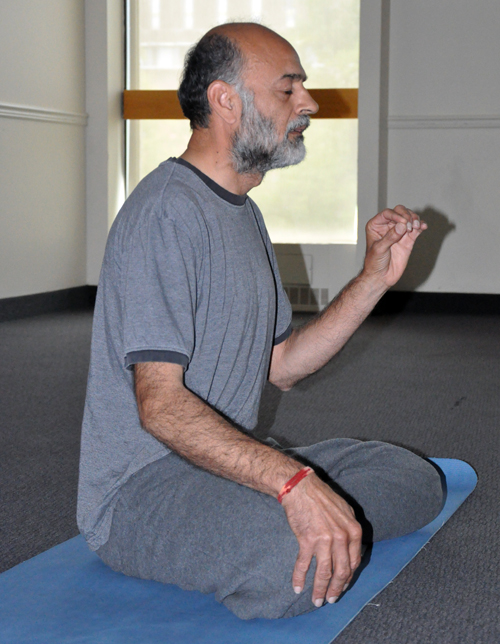
Did you do some yoga today? If you did, you probably feel better already.
“I have never felt so amazing in my life,” says Lalit Jairath, an analyst in Computing and Communications Services who teaches yoga on campus. “I feel so young.”
Since he started practising yoga regularly, he says, he has never had a headache — and his seasonal allergies have disappeared, which he credits to yoga’s immunity-boosting benefits. Yoga may even help prevent cancer, he says, by filling the body’s cells with oxygen. “The cancerous cells don’t like oxygen. It’s not going to cure it, but it may help to prevent it.” Yoga has also helped improve his relationships with friends, family and colleagues.
Born in India, Jairath taught comparative veterinary anatomy, statistics and animal genetics before coming to Canada in 1988 to pursue a PhD at McGill University. Although he grew up in a country where yoga is a part of life, he began daily yoga only about two years ago. “Now I practise every day for about one-and-a-half hours in the morning. I get up early.” How early? Five-thirty. He says the best time for yoga is early in the morning when the mind is clear of distractions.
First thing in the morning, he drinks at least one litre of lukewarm water lightly sweetened with honey or flavoured with lemon, ginger or cinnamon. He says this practice helps remove toxins from the body and clear the mind. He recommends starting with one glass of water and gradually increasing to a litre or more.
“Yoga is a way of life,” says Jairath. “Yoga is more like a perennial philosophy. Yoga is a science of total health; it’s a science of awareness” When he heard about O.P. Dwivedi, a political science professor emeritus who was teaching yoga on campus, he decided to become a certified yoga instructor by taking a training course at the Athletics Centre. After meeting the instructor, Jiwan Goyal, Jairath was impressed: “He was living yoga; he was not just teaching yoga.” A graduate of The Yoga Institute in Mumbai, India, the oldest yoga centre in the world, Goyal has taught yoga for more than 30 years.
This fall, Jairath is teaching a free yoga class for staff and faculty called “Classical Yoga for Total Health and Awareness,” Tuesdays at noon in UC 442. “We’re always looking for new people,” he says. “I want to see a room that is full.” He also teaches weekly yoga classes at the Athletics Centre and offers one-on-one consultations (Ext. 58673 or ljairath@uoguelph.ca).
“The U of G Athletics Centre offers one of the best yoga programs in the country,” he says. “Thanks to Athletics Centre management and staff, there is a groundswell of yoga practitioners emerging at our University.” He adds that about 15 million Americans — almost half the population of Canada — practise yoga daily.
Jairath donates all proceeds from his classes to U of G’s BetterPlanet Project and Dwivedi’s charity, which is building an eye hospital in India. He also plans to donate money to the Athletics Centre to purchase yoga mats to be given to students in a draw. “It’s good to have your own mat, because your mat gathers your own energy as you spend hours practising yoga on it,” he says. “When you open it up and sit down, it comes back to you.” You need no other equipment to do yoga, unlike other exercise routines.
“Yoga is more than the physical, yoga is more than coming into a pose,” says Jairath. “Yoga provides the road map for your whole life path. It’s physical, mental, emotional, moral and spiritual. It’s balanced. People are always looking for balance.”
Modern stresses can trigger the fight-or-flight response, he explains, while yoga poses, or asanas, stimulate the rest-and-digest response. Yoga can help relieve stress by regulating the production of the stress hormone cortisol.
One way to promote relaxation is to practise breathing exercises such as alternate nostril breathing. Press your right thumb against your right nostril while inhaling slowly through the left nostril. Then block the left nostril with your ring finger while exhaling and then inhaling through the right. Keep alternating until you feel relaxed.
The yogic lifestyle also includes healthy and mindful eating habits. Jairath says most diets fail because people are unwilling to go beyond short-term dieting. “It’s not about losing weight; it’s about gaining health,” he says.
Yogic philosophy suggests eating every four hours. Stop eating when your stomach is half full, leaving room for water and digestive gases. Don’t drink water during or immediately after a meal. A typical yogic diet includes a variety of fruits and vegetables, particularly green leafy vegetables, nuts, seeds, whole grains, legumes, beans, honey, water and milk.
Staying focused is one of yoga’s biggest challenges but also one of its biggest rewards. “If you live in the present moment, you will never be unhappy,” says Jairath. He hopes U of G will someday offer a yoga studies course for its educational value and as a tool for self-development. “That would definitely set U of G apart from other institutes of higher learning,” he says. “That could be one of the differentiating factors when choosing amongst the universities.”